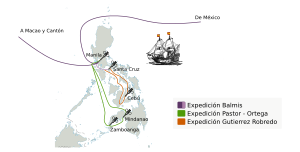Rafael María de Aguilar y Ponce de León facts for kids
Quick facts for kids
Rafael María de Aguilar y Ponce de León
|
|
|---|---|
| 56th Governor-General of the Philippines | |
| In office 1 September 1793 – 7 August 1806 |
|
| Preceded by | Félix Berenguer de Marquina |
| Succeeded by | Mariano Fernández de Folgueras |
| Personal details | |
| Born | c. 1737 Écija, Kingdom of Spain |
| Died | 8 August 1806 (aged 68–69) Manila, Captaincy General of the Philippines |
| Awards | Order of Alcántara |
| Military service | |
| Allegiance | |
| Branch/service | Spanish Army |
| Rank | Field Marshal |
Rafael María de Aguilar y Ponce de León was an important Spanish military officer. He served as the 56th Governor-General of the Philippines. This position was called Gobernador Géneral in Spanish. He was the longest-serving governor in the Spanish Philippines.
Contents
Who Was Rafael de Aguilar?
Not much is known about Rafael de Aguilar's early life. Before he became Governor-General, he was a military officer. He also served as a gentleman of the bedchamber to the king. His service in the military earned him a special award called the Order of Alcántara.
Aguilar arrived in the Philippines on August 28, 1793. He officially started his job on September 1. King Charles IV of Spain chose him for this important role. His time as governor was shaped by new ideas from the Enlightenment in Spain. These ideas focused on making things better and more modern. Aguilar served for 12 years and 11 months. This made him the longest-serving Spanish Governor-General of the Philippines.
Aguilar's Time as Governor
One of Aguilar's main achievements was making the Philippines safer. He worked to improve the defenses of the islands.
Protecting the Islands
Stronger forts were built in Cavite. In 1794, a place to build ships was made in Binondo, Manila. A naval base was also built at Corregidor. These places helped build boats for military actions. These boats were used to protect the islands from groups like the Moros.
In 1796, two groups of professional native soldiers were formed. This was the first time local soldiers became full-time professionals. They were called Granaderos de Luzon (Luzon Grenadiers) and Granaderos de Batangas (Batangas Grenadiers). Five groups of part-time soldiers, called militia, were also created. In 1800, a Naval Command was set up. Its job was to check foreign ships entering the islands. Six years later, a force of 300 marine grenadiers was organized.
Trade and Modernization
Aguilar also worked to open Manila for foreign trade. Other governors had tried this before him. However, it was not fully opened until 1834. This happened by a special royal order.
He also helped to print and share a new version of the "Ordinances of Good Government." These were like rules for how the government should work. In 1804, Aguilar suggested making Manila more modern. This included big public building projects. He also created cultural places and added streetlights to Manila.
Fighting Smallpox
During Aguilar's time, the Balmis Expedition arrived in the Philippines. This expedition took place from 1803 to 1806. It was led by Doctor Francisco Javier de Balmis. The main goal was to give people vaccinations against smallpox. The Philippines was one of the places this important mission visited.
Rafael María de Aguilar died on August 8, 1806. This was just one day after Mariano Fernández de Folgueras took over as governor.
See also
 In Spanish: Rafael María de Aguilar y Ponce de León para niños
In Spanish: Rafael María de Aguilar y Ponce de León para niños


